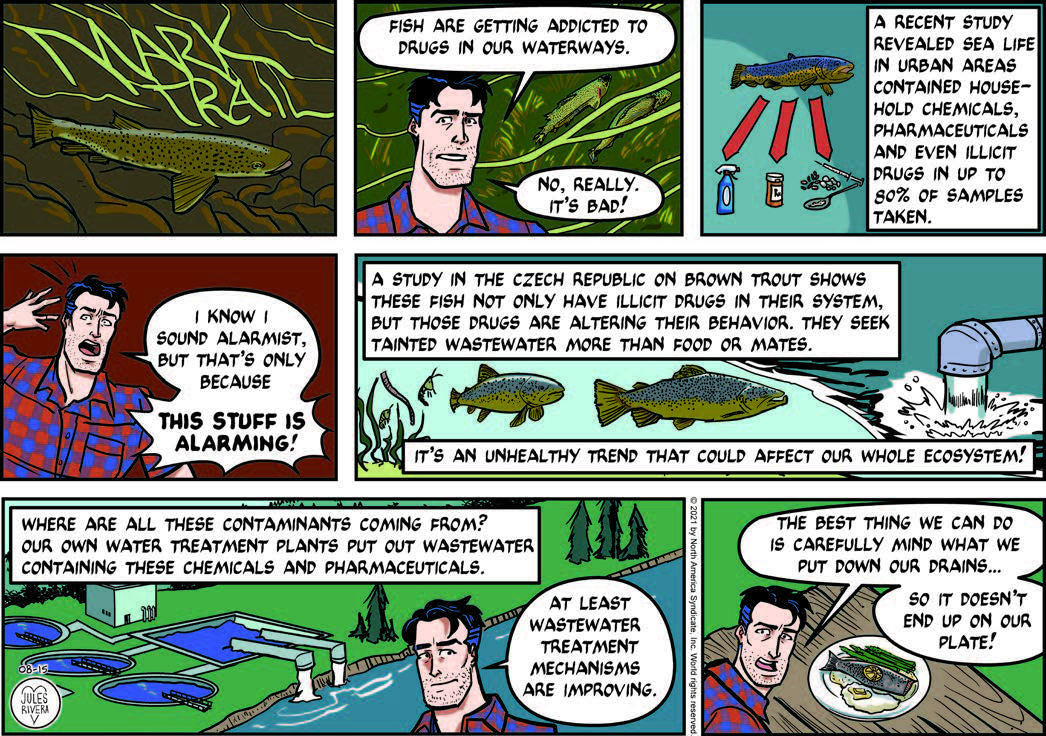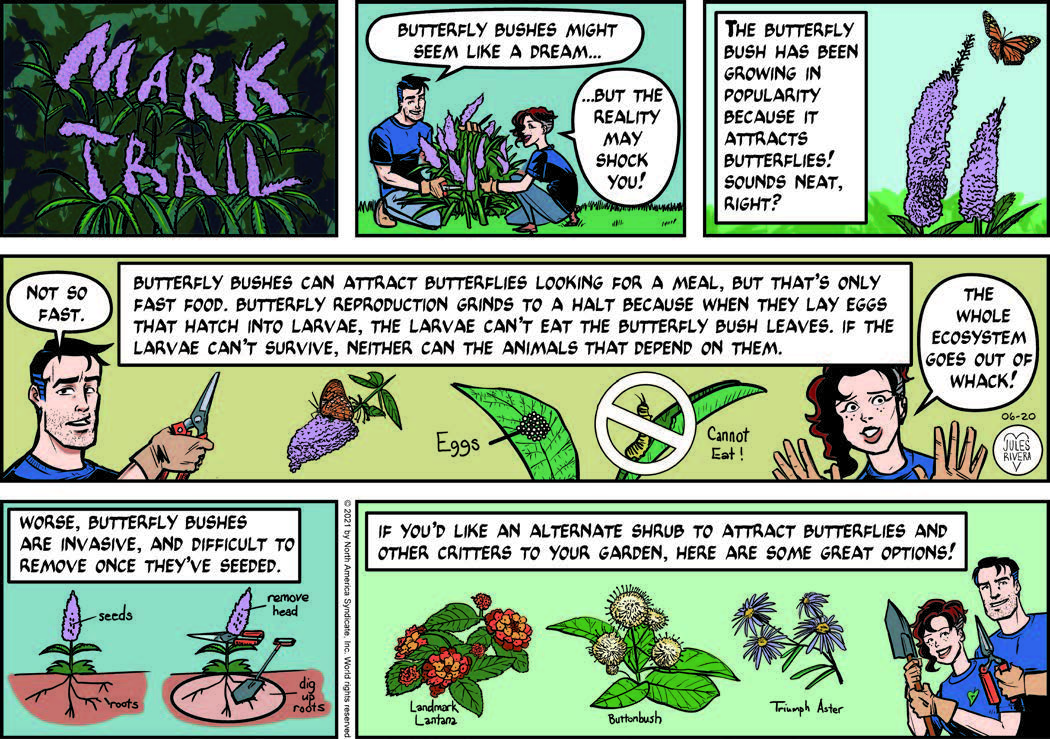After hiking in the woods, rescuing wildlife and putting the hurt on bad guys for nearly 75 years, Mark Trail was ready for a break.
At least that’s what King Features Syndicate thought, the company that publishes the “Mark Trail” cartoon strip.
They decided: time for a makeover for the beloved World War II veteran who ekes out a living as a freelance writer for Woods and Wildlife Magazine.
Mark Trail 2.0 is a millennial.
Now he shaves less frequently, seems to have bought some new clothes – and he has a new artist drawing him. Starting in October 2020, Jules Rivera began penning the cartoon and writing the weekly story lines. She also creates the Sunday science cartoon strips, which typically tackle a specific conservation or wildlife topic.
Of course, some things never change. Mark is still an outdoor writer, a champion of wildlife, married to Cherry, dad to Rusty with trusted dog Andy nearby. Plots typically involve wild places and critters, bad jokes and pancakes.
Created by cartoonist Ed Dodd in 1946, the strip grew in popularity over the years. At its peak, the cartoon was running in more than 300 newspapers in the U.S. and 55 more papers abroad.
Tea Fougner is editorial director for comics at King Features Syndicate, and she worked on the transition to a more modern Mark.
“When Ed Dodd began Mark Trail, his mission was to educate ordinary people about wildlife, nature and conservation,” Fougner says.
“We realized that to really continue Ed’s mission of bringing natural science to everyone, it was important to make Mark, Cherry and Rusty broadly relatable to today’s audience, and for them to deal not only with current events but with the kinds of issues facing millennial parents and their kids today.”
 Cartoonist Jules Rivera has spent the past year penning the Mark Trail strip, which chronicles the adventures of the legendary outdoor writer who first appeared in the funny pages in 1946.“Jules Rivera’s background in STEM [science, technology, engineering and math] as well as webcomics made her a great fit,” Fougner says. “In today’s world, we know that these issues have become even more important, and it’s up to all of us to take care of our world.”
Cartoonist Jules Rivera has spent the past year penning the Mark Trail strip, which chronicles the adventures of the legendary outdoor writer who first appeared in the funny pages in 1946.“Jules Rivera’s background in STEM [science, technology, engineering and math] as well as webcomics made her a great fit,” Fougner says. “In today’s world, we know that these issues have become even more important, and it’s up to all of us to take care of our world.”
Rivera strives to reach a broader audience by presenting underrepresented people, seen through the “Mark Trail” story lines.
“I am a woman of color who got bounced out of STEM because my working environment was so toxic,” she tells Outdoor America. “I put people of color and marginalized gender in my stories doing things… that make people feel seen, and human. When readers can emotionally connect to a story, they can connect to its message a lot easier.”
“The focus is always on what can be done moving forward,” she says. “The audience can take bad news if they feel like they can do something to fix it.”
 Before the transition to Mark as a millennial, the cartoon was written by creator Ed Dodd and later by Jack Elrod and James Allen.
Before the transition to Mark as a millennial, the cartoon was written by creator Ed Dodd and later by Jack Elrod and James Allen.
“In 1946, Mark Trail was the right concept at the right time, a returning GI hankering for the literal peace and quiet of the wilderness when thousands of actual GIs were returning from war hungry for a similar return to normalcy,” says Mark Carlson-Ghost, a cartoon historian and retired psychology professor. It was a realistic cartoon strip but unlike other comics of that era, the focus on hunting, fishing and conservation was unique.
After Ed Dodd retired from the strip, Jack Elrod and more recently James Allen continued to draw the traditional “Mark Trail.”
Carlson-Ghost says, “Rivera’s artistic regime has been especially successful in revitalizing the Sunday strips, which have always been educational in nature.” They had grown a bit stodgy, he says, but they now include more sparks of humor.
Like conservation broadly, "Mark Trail" is keeping up with the times. While the comic features fictional characters, the topics it tackles are very real.
How is the public responding? “It’s such a joy every time I read a fan letter from a scientist or wildlife activist who is just elated that Jules brought a subject that matters to them to a broader audience,” says Fougner.
Having the opportunity to share thoughts with the new cartoonist, Outdoor America could not resist bragging about Salt Watch, Save Our Streams and various strategies and programs the Izaak Walton League uses to enlist citizen scientists and foster local conservation.
“That all sounds pretty cool! I’d be interested in trying out some of these apps. I love how technology is changing how we learn about the natural world,” Rivera says.
So, like conservation broadly, “Mark Trail” is keeping up with the times. And while the comic strip features fictional characters, the topics it tackles are very real.
Throughout the post-World War II era, when concerns about wildlife and forest management produced many of our nation’s modern environmental policies and ethics, the “Mark Trail” cartoon strip touched on many of the same topics of concern that the Izaak Walton League worked on during that period.
As a freelance outdoors writer, Mark Trail would likely have been a member of the Outdoor Writers of America Association, which was formed at the 1927 Izaak Walton League convention. It remains a very active organization today.

Exclusive Interview with Mark Trail
Outdoor America was able to wrangle this exclusive and perhaps first-ever interview with legendary outdoor writer and cartoon character Mark Trail.
OA: Mr. Trail…can I call you Mark? Thanks for talking with me. I know you’re busy.
Mark: I’m never too busy to talk about the outdoors. And Mark is fine – just as long as you don’t call me late to dinner! …or L’il Marky.
OA: Got it. As an outdoor writer – probably a better career choice than comedian – you have a lot of close encounters with the natural world. Does that ever get old? Do you still get goose bumps out there?
Mark: Did you know geese don’t get goose bumps? Only mammals can. They’re the result of tiny muscles attached to every hair follicle on your body! And boy do I get those. There’s so many wonders of nature, and new ones being discovered every day. This year, we discovered the smallest reptile known to science, the nanochameleon, or Brookesia nana. There’s always something new to learn!
OA: As I just did. Thank you. You also keep your eye on threats to wildlife and their habitat and other problems. Do you worry about that? What keeps you up at night?
Mark: Other than Andy snoring, the thing that keeps me awake the most is thinking about the world we are leaving behind for our kids. As a dad, I worry about increasingly dangerous weather, wildfires out of control, endangered species under constant threat of extinction, and the depletion of resources that come with rising global temperatures.
A glass of warm milk at night helps.
OA: Other side of that coin: With so many negative trends – climate change, the extinction crisis – what gives you hope?
Mark: Young people’s passion for the environment and the urgency with which they are fighting for the earth! Heck, if it weren’t for them, I’d be out of a job! But more important, it makes me feel confident that we’re leaving the future of our planet in good hands…but we need to take care of it well enough to hand it off.
OA: So what advice do you have for people who want to help protect wild places and wildlife?
Mark: The number-one thing you can do without any training is to make sure you pick up your trash and recycle or dispose of it properly. Litter can be hard on local animals and plants! Always try to re-use items if you can, and if you can’t, find out whether they can safely be disposed of in the regular trash or your local recycling program, or need to be recycled through a special program.
OA: Mark, you’ve been at the peak of your career for… a really long time. Are there any assignments or challenges you would like to take on that you haven’t yet?
Mark: That’s a tough question! There are definitely parts of the world I would love to explore! One natural phenomenon I’ve always wanted to see is a mud volcano. Mud volcanoes aren’t “real” volcanoes. They’re what happens when gas beneath the earth’s surface bubbles up, pushing mud, silt, and clay with it, they’re sort of like nature’s burps! They’re most plentiful and active in Azerbaijan, a country I’ve never been to. If you need someone to report from Azerbaijan, I’m your guy!
OA: Mud volcanoes. Awesome. Finally, and this can be off the record, but I noticed you have a new look. Are you using a different hair product?
Mark: Beats me! I just use whatever Cherry puts in the shower. I did get an electric razor as a birthday present last year. It keeps me from cutting myself, but it does leave more stubble!
Cherry Trail, Mark’s wife and partner in conservation, joins the conversation.
OA: Thank you for joining, Cherry! I’ve noticed that you are very focused on native plants and the importance of keeping ecosystems healthy and intact. What can folks do in their own communities to promote conservation?
Cherry: Talk to your community about maintaining as many native plants as possible in yards, parks and other recreational areas. A great project for a local school can be to plant a garden using only native plants. Kids get to learn about their environment and how to maintain that for generations to come!
Another thing you can do is trade in your traditional sod lawn for a yard of native grasses and plants. This helps enrich natural wildlife and prevents flooding and erosion. Native plants are always the best ones for your yard. It costs ya’ less water too!
OA: What is your vision for the future? What type of world do you want Rusty to grow old in?
Cherry: One where he makes his bed – just kidding, just kidding! I want to see Rusty grow old in a world where people have compassion for each other’s differences and a real community spirit to solving problems! We shouldn’t just pay attention when someone rich or famous brings an issue to our attention. We need to listen when people who don’t usually have a voice tell us something is wrong.
OA: Thanks for those insights. Cherry, Mark always presents as super competent. What is he really bad at?
Cherry: He sometimes just gets so excited about something he’s learned that he just won’t stop talking about it. It’s endearing as heck until you’ve heard about the mud volcanoes in Azerbaijan for the fifteenth time on your hike. You try to change the subject, but he just won’t take a hint. In our house, we call this “Marksplaining.” And boy, our boat insurance sure is expensive.
OA: Thank you, Cherry and Mark. Keep up the great work. We should make both of you lifetime members of the Izaak Walton League as thanks for your work to inform people about conservation.
A big thanks to Jules Rivera and Tea Fougner for allowing Outdoor America to “interview” Mark and Cherry, and for channeling the Trails.

This article was excerpted from “Outdoor America” 2021 issue #4. Want more articles like this? Join the League and get four issues of our award-winning magazine every year.
Join the Izaak Walton League
Michael Reinemer is editor of Outdoor America and communications director for the Izaak Walton League.